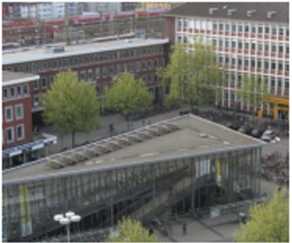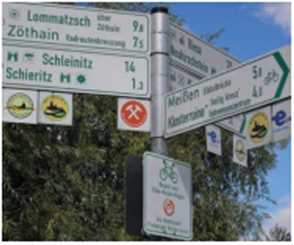9220598010
CMbiiO/
Central MeetBike
Fact SHEET H-09 - SlGNPOSTING AND Service Infrastructure
Service stations

Servtoe staton in Munster with underground parkjng and service facutes (souroe. Jan Schubert)
Signposting
Since cyde route networks may bear charactenstics that are different from the dassic road network. signposting helps cydists to fmd the best and most convement route to their destination. Cyde routes often include shortcuts or paths through green areas. which may be located morę easily by cydists unfa-miliar with the network when indicated through signage.
Signposting is also a form of public relations. The consistent use of stan-dardised colours. symbols and fonts for wayfinding creates an easily recognis-able identity for cyding in a town. region or country. Signposting also helps to make bicycle routes morę visible and noticeable not only for cydists.
Implementing signposting is based on a signposting plan that corresponds with the desired bicyde route network (see Fact Sheet H-01). Furthermore it should define primary and secondary destinations within the area. It is impor-tant to provide continuous signage to the posted destinations. This ensures a cohesive wayfinding system free of gaps. In some cases coordmation with neighbouring municipalities or regions may be necessary to ensure route con-tinuity for trans-regional destinations.
Different user needs. especially of commuters, recreational cydists and tounsts should be taken into account. Commuters. for example. will reguire morę direct routes for everyday use whereas tounsts may prefer thematic or scenie routes. Different user groups will also have differing needs regardmg destinations.
Since the use of numerous signposting systems will result in a sign clutter especially at intersections it is recom-mended that a standard be defined on local or - even better - on regional or national level. Signs should be desig-ned in a way that allows for easy rea-ding from a typical distance of approa-ching cydists. They should not include morę than two destinations per direc-tion and corresponding distances.

Wayfinding wrth two destinations per s«gn and easily recogrwable s^gns lor var»us routes, tor example the blue *e‘ tor EJbe Cycle Path (sour-ce. Kevm Wncent)
Service stations are a combination of bicycle garage with monitored parking, mobility services and facilities for re-pairs and maintenance of bicydes. Mobility services can indude bicyde rental facilites or information for tounsts. Pla-dng the station at a location where the volume of cydists is high (e.g. a train station in the form of Bike+Ride) is recommended. Additionally. it is user-fnendly. Commuters who ride their bł-cycle to the station can have it repaired while they are working and pick it up on the way home.
Stations in Germany (e.g. in Munster, Kieł. Erfurt and Hanover) usually vary in size. types of parking facilities and rangę of services. Since bicycles usually will be parked for long penods. ap-propriate parking facilities are recommended (see Fact Sheet H-08). Some stations also indude shops or information stands from local public transport companies. Repair shops sometimes operate in cooperation with a soctal as-sociation involving people that are dif-ficult to place on the job market in order to give them employment.

Wyszukiwarka
Podobne podstrony:
CMbiiO/ Central MeetBikeFact Sheet H-07 - Traffic Calming MeasuresObjectives of traffic calming Traf
CMbii^Central MeetBikelFact Sheet H-06 - Rural Cycling (daily and leisure routes) Necessity of rural
ZmbiH Central MeetBike AFact Sheet H-08 - Bicycle Parking Facilities Introduction Ouality bicycle pa
f2 2 ^Netscape - [JavaSoft Products and Services] File Edit View Go Bookmarks Options Directory Wind
READING Open dozęTOPIĆ Shopping and services EXAM TIPS ► Read the text through ąui
SPEAKING Discussing a topieTOPIĆ Shopping and services The audio trackfor this actwity can be found
Rathmell 1997 Good is a noun, service is a verb. Good is an object, a device and service is a deed,
4. Japan Educational Exchanges and Services, The Japan Foundation: Japanese
3.2. Information on products and services ENEA S.A. sells electrical energy to recipients and offers
Global, virtual materials warehouse with morę than150.000 Products and services Digital access to3.5
Daewoo AKF 9531 djvu AudioTeh.com - Free Schematic Diagrams and Service ManualsCONTENTS •
cp 09 POSTURĘ AND HEALT H—By Arnold H. Kegel. MD. all limes whether standing. walking or sitting. By
ProgramProdukcjiSTAR24 KONSTRUKCJE STALOWE I TRANZYTOWE STACJE OBSŁUGISTEEL STRUCTURES AND TRANSIT S
Materiały dla maturzystów DŁUŻSZA FORMA UŻYTKOWA TASK 7 (słownictwo : Shopping and services) Podczas
więcej podobnych podstron